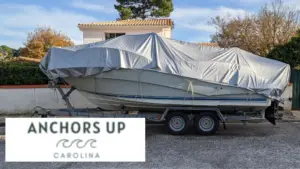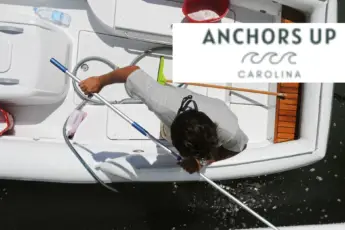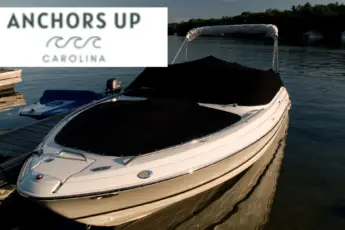Approaching hurricanes increases the level of stress and anxiety among boat owners. Boats are subject to extensive damage with the combination of storm surges and winds. While not all boaters store a boat in the water, even trailer vessels are at risk of excessive damage. I was fortunate to have stored my vessel in a hurricane rated dry rack facility. However, no matter if you’re pulling your boat out of the water or keeping it on a trailer, you need to know how to secure it properly. So, if you’re wondering how to secure a boat on a trailer during a hurricane, follow these steps.
Why Boats Are At Risk Of Damage While On A Trailer In A Hurricane
Again, we all know the risks of a hurricane when a vessel is tied dockside. The combination of rising water and stiff winds puts boats at risk of severe damage or sinking.
Without question, storing a boat on a trailer is a safer alternative. However, that comes with a catch. Don’t assume that you can load up the trailer and walk away. More steps are required to better protect your investment from a hurricane.
Falling Objects
I’ll be honest: you can’t eliminate damage from falling objects or airborne projectiles. However, you can minimize the risk.
Undoubtedly, you’ll want to be smart when it comes to the location you store the vessel. When positioning the trailer and boat, identify tall trees and other objects that are at risk of falling. Make your best effort to keep the vessel out of range in the event they are knocked down in the hurricane.
Again, I know it is highly unlikely to find a spot that completely eliminates the risk of falling objects.
Wind Damage
A hurricane is a hurricane, and that means excessive winds. Unfortunately, you’re not going to dodge the wind unless you find a hurricane rated building.
With that being said, strategic placement can help. Make an effort to position the vessel along the side of a house or fixed object. A fixed object will reduce the wind speed, thus reducing the chances of the trailer and boat overturning.
Wind damage, for the most part, in a hurricane is unavoidable. Remember, take all necessary precautions to reduce the risk.
Flooding
Without a doubt, flooding is associated with hurricanes between heavy rainfall and storm surge. The risk of flooding is highly dependent on location. Areas along the coast are prone to storm surges compared to inland properties. For this reason, you’re at higher risk if you place your boat on a trailer and leave it in the marina parking lot.
However, don’t overlook the risk with inland properties. Inland areas along creeks, rivers, and lakes are also subject to flooding. As heavy rain pours down, the water level rises above the banks. With that being said, if you’re in an area that is at risk of flooding, store your boat and trailer elsewhere on higher land.
So, How To Secure A Boat On A Trailer During A Hurricane
The process of securing a boat to a trailer is relatively straightforward. However, you’ll want to have all supplies on hand so you don’t have to go back and forth to the store. Remember, don’t wait until the last minute to begin preparations.
Plan Ahead Of Time
When the forecast calls for a hurricane, this is the time to start preparing. Trust me; you’re better to be over prepared compared to under prepared.
One of the best ways to prepare is to gather a hammer drill, hammer drill bit, four concrete eye bolts, and two nylon ratcheting straps.
In addition to supplies, pick a location that is most protected and away from objects at risk of falling. Additionally, you’ll want to position the boat and trailer on concrete. Concrete is required to drill and set the concrete eye bolts.
Position The Boat And Trailer
Remember, positioning is key. Make your best effort to place the boat in an area that offers any sort of protection from wind.
In addition to wind protection, is placing the boat away from areas that are subject to rising water. Don’t park the trailer and boat within close proximity to the banks of lakes, creeks, and rivers.
Secure The Vessel To The Concrete
Once the boat and trailer are in position, it is time to lock it in position. Unfortunately, you will need to drill 4 holes in the concrete to position the eye bolts. However, the eye bolts are fundamental in preventing the boat from blowing away.
Drill one hole in each of the following locations. One on the left side of the trailer in the concrete and one on the right side of the trailer in the concrete. The two should line up on each to the center point of the bow.
Importantly, the same applies to the stern of the watercraft. Drill a hole in the concrete on the left and right side about four feet forward of the transom.
Once the holes are drilled, place the eye bolts in position. The next step is to secure the ratcheting nylon straps to the eye bolts.
Attach the nylon strap hook to one eye positioned at the bow. Run the strap over the top of the bow and across to the opposite eye. I suggest placing a rag at the contact point of the strap and the hull. The rag will prevent damage when torquing down on the strap. Tighten the strap until it is snug.
Again, the same applies to the stern. Remember, ensure that the strap is tightened well to prevent the boat from lifting up.
Secure Your Boat And Trailer When A Hurricane Approaches
So now you know how to secure a boat on a trailer during a hurricane. I can’t stress this enough, but it is essential to do so well in advance of the approaching storm. Too often, people are delayed and are forced to scramble when the wind is picking up speed. Unfortunately, the most powerful hurricanes put your boat and trailer at risk no matter how much effort you make. However, it is worth making the effort and hoping for a good outcome.






